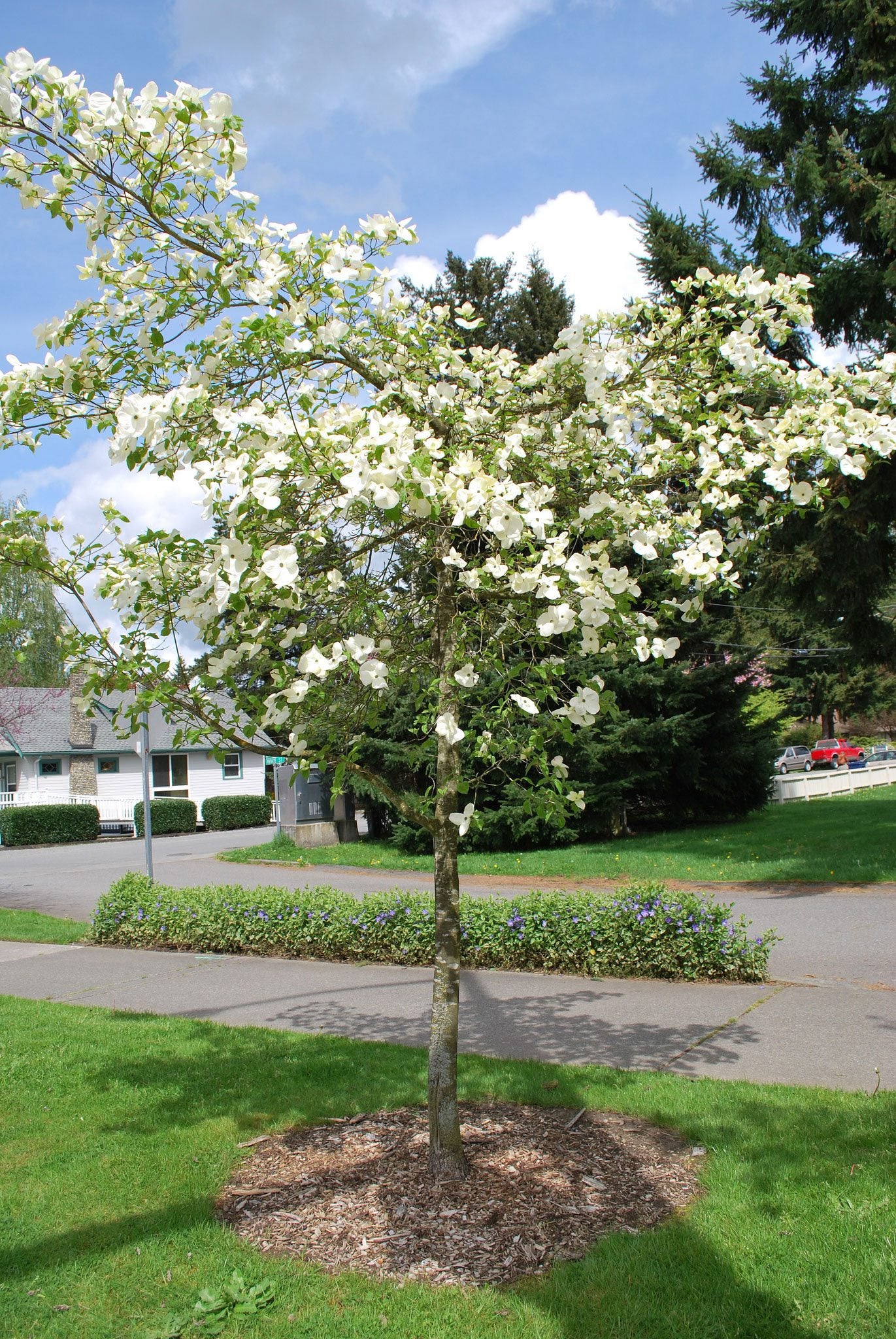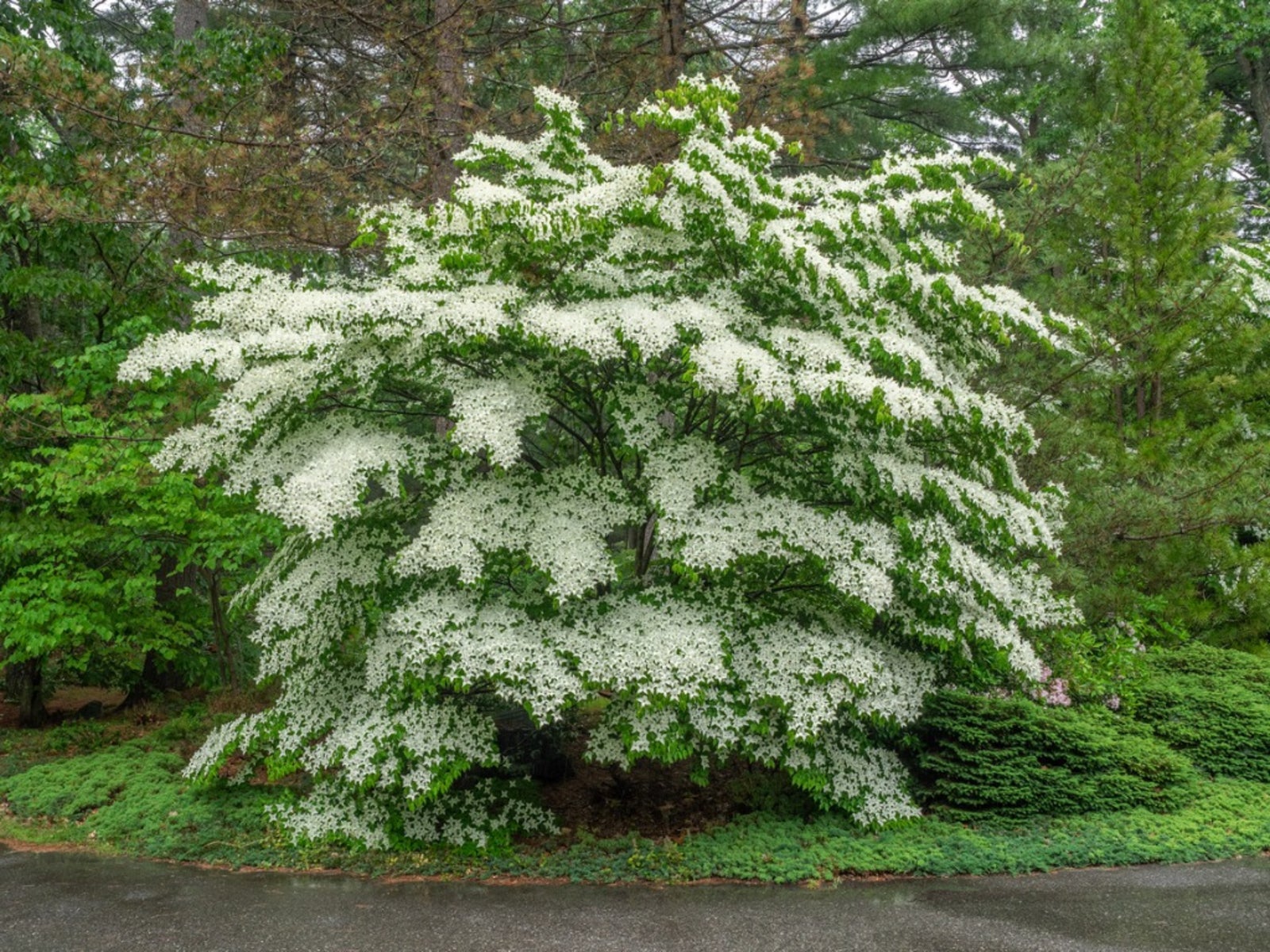pagoda dogwood tree care
The young stems are deep purplish brown and bear alternate ovate dark green leaves up to 5 in. Pagoda or alternate-leaf dogwood C.

Transplanting Dogwoods When And How To Transplant A Dogwood Tree
With its large white flowers in spring followed by clusters of black berries loved by birds this native tree is ideal for small gardens shady places and natural plantings.

. It is also unique in that its leaves are arranged alternately along the stem thus its other common name alternate-leaf dogwood. An excellent landscape shrub Pagoda Dogwood Cornus alternifolia is a deciduous shrub or small understory tree. The leaves turn a soft maroon color in the fall.
The foliage may turn reddish purple in the fall. How to care for dogwood trees. Capitata - Hardy in USDA zones 8 and 9 the evergreen dogwood grows as wide as it does high.
Dogwoods need very little unless you are trying to keep them a certain size. The fall color is deep red and the white flowers are produced in clusters in the spring. Department of Agriculture plant hardiness zones 3 through 7.
The pagoda dogwood is hardy in the US. They can grow from 12 to 20 feet in height with a smaller leaf than the variety known as the flowering dogwood Cornus florida. Pagoda dogwoods are large shrubs to small trees.
Pagoda Dogwood is the perfect choice for a naturalized landscape where you can sit and watch the birds that are attracted to the fruit. Pagoda dogwood is known for its pagoda-like horizontally layered branching habit. A 10-30-10 is an excellent mix for flowering trees.
15 to 25 feet tall may be 15 times that wide. The Pagoda Dogwood is ideal to plant along buildings or yards that have much shade or large trees. 12 to 18 inches.
Expand that distance to 15 feet on center to create an individual tree that doesnt touch its neighbor. It is also unique in that its leaves are arranged alternately along the stem thus its other common name. The Pagoda Dogwood is a native large shrub or small tree with horizontally spreading branches in irregular tiers.
Planting Care for Deciduous Shrub Pagoda Dogwood Shrub Cornus alternifolia Preparation. Golden Shadows Pagoda Dogwood Care. You want the root area of the tree to stay cool at all times of the day.
This is a slow growing plant that will need a minimal amount of pruning. Water with frequency and do not allow the soil to dry because this. The tree grows in sun or shade.
Planting the tree in a section of your backyard with filtered shade will minimize Golden Shadows dogwood care. This dogwood has a beautiful red-purple fall color that will add interest to your landscape. It makes for a distinctive specimen or accent plant.
An excellent landscape shrub Pagoda Dogwood Cornus alternifolia is a deciduous shrub or small understory tree. Only prune in early spring before the plant leafs out. Fragrant white flower clusters in spring are followed by dark blue berries on red stems.
But not hardy in the north. Good alternative to cold-sensitive Flowering Dogwood Cornus florida in northern areas. Pagoda dogwood Cornus alternifolia is a large shrub or small tree for a garden or backyard.
Michigan State University Extension. It prefers partial sun a moist well-drained site and a rich soil that is somewhat acidic. Pagoda dogwood lacks the showy bracts but the many white flowers hovering over the dark green leaves can still be very attractive.
Apply 4 to 6 inches of mulch around the base of your dogwood tree. The Pagoda Dogwood is a little-known tree that can bring real grace to cold gardens. Flat-topped clusters of fragrant yellowish white flowers in May or June are followed by handsome blue-black berries on red stems.
It makes for a distinctive specimen or. Plant in light shade or morning sun. Although pagoda dogwood is its common name it is a North America native plant.
Alternifolia - Its tiered horizontal branches mimic the shape of a pagoda. Pagoda Dogwood grows slowly at first but becomes moderate with age. Pagoda dogwood is hardier and suitable for zones 4 through 7.
For something special in your garden this is the tree to choose. Pagoda dogwood prefers part shade and moist slightly acidic well-drained soil. Planting in a wind-protected site is recommended.
Measure from the center of one to the center of the next. Direct sun can burn the cultivars beautiful leaves. Bluish-black fruit are produced after the flowers.
The dogwood tree is associated with a. Unlike most members of the dogwood family that have opposite leaves pagoda dogwood has an alternate leaf arrangement. For more pagoda dogwood information including tips for pagoda dogwood care read on.
Its unique horizontal branching pattern has a distinct tiered habit. Low branches should also be removed if a. Remember that no blooms will be created for at least 10 years so giving the tree fertilizer in those first 10 years is wasting nutrients.
The hotter your climate the more shade the tree will need. Pagoda dogwood is a native low-branched tree reaching a mature height of 15 to 25 feet and 20 to 32 feet in width. It is also an attractive plant.
Pruning however can be very important to the overall look of the plant. Spreading horizontal low-branched tree with great horizontal habit. It is preferred that you use acidic soil for gardening.
Masses of tiny white fragrant flowers appear in early summer. Keep the soil damp but not so that it forms mud or that water accumulates on the surface. Crossing badly formed or damaged branches should be removed back to a main branch.
Fall foliage is generally reddish purple. Underplant with a special easy care collection. When your Japanese pagoda begins to blooms you will want to use a fertilizer with an NPK formulation with high phosphorous as your fertilizer of choice.
However neutral soil also works. Burgundy foliage in fall. A spectacular specimen tree in the landscape Cornus alternifolia Pagoda Dogwood is a small deciduous tree or large multi-stemmed shrub with beautifully layered horizontal branches.
In late spring to early summer small. Flowering dogwood is native to the US. Strong horizontal branching that resembles the spreading roof line of a pagoda creates an attractive winter silhouette while bare and a soft beautifully tiered effect when covered with dark green summer foliage.
In terms of soil youll do best growing Golden Shadows dogwood in moist well-draining soil. Its common name pagoda reflects the tree growth pattern which is similar to the shape of the Asian religious structures.

Cornus Alternifolia An Unusual Pagoda Dogwood Tree Youtube

Dogwood Pagoda Pruning Winter Care And Fertilizing Hawks Landscape Inc

Pagoda Dogwood Care Learn About Growing Pagoda Dogwood Trees Dummer Garden Manage Gfinger Es La App De Jardineria Mas Profesional

Home Pagoda Dogwood Dogwood Trees Amazing Gardens

Pruning For Form The Tale Of 2 Dogwoods Earthdance Organics Lawn And Plant Care

Pagoda Dogwood Information What Are Pagoda Dogwood Growing Conditions

Flowering Dogwood Problem Dogwood Trees Flowers Not Blooming Or Forming

Pagoda Dogwood Brush Layers For Sale Wholesale Nursery

Pagoda Dogwood Knowledgebase Johnson S Nursery

Pagoda Dogwood Care Learn About Growing Pagoda Dogwood Trees Dummer Garden Manage Gfinger Es La App De Jardineria Mas Profesional

Get Pagoda Dogwood In Mi At English Gardens Nurseries Serving Clinton Township Dearborn Heights Eastpointe Royal Oak West Bloomfield And The Plymouth Ann Arbor Michigan Areas

Pagoda Dogwood Grasshopper Gardens

Pagoda Dogwood A Truly Elegant Garden Tree Horticulture

Cornus Kousa Pagoda Dogwood Tree Sugar Creek Gardens

Dogwood Pagoda Nebraska Forest Service

Flowering Dogwood Tree Care How To Plant And Prune Cornus Trees

Pagoda Dogwood Shrub Cornus Alternifolia Mckay Nursery

Pagoda Dogwood The Multi Layered Tree Leaf Local Enhancement Appreciation Of Forests
